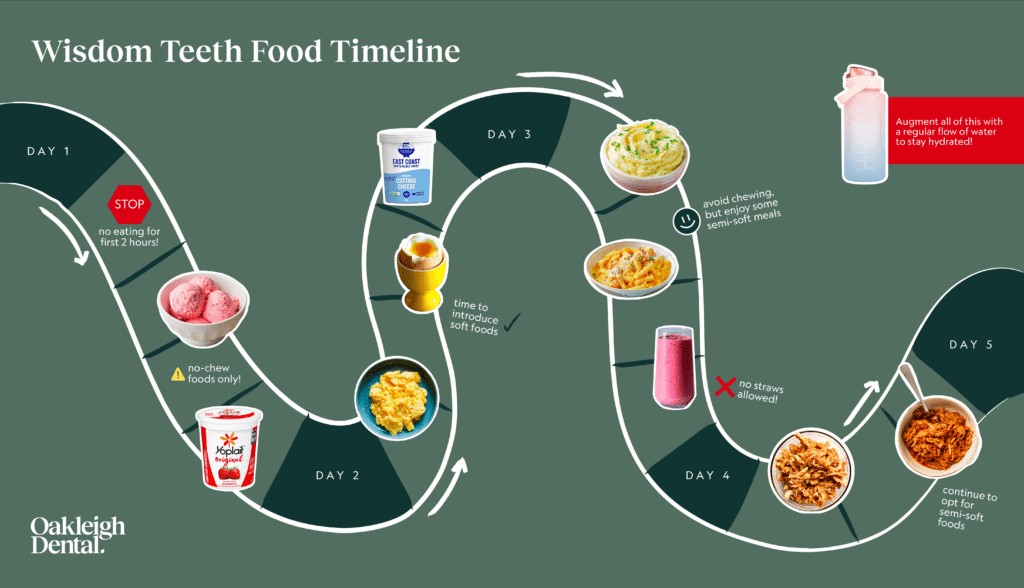Recovering from wisdom teeth removal requires careful attention to what you eat. Knowing what foods are safe and what to avoid can significantly impact your healing process. This guide provides a comprehensive overview of what you can eat after wisdom teeth extraction to ensure a smooth recovery.
Why Diet Matters After Wisdom Teeth Extraction
Following wisdom teeth removal, your mouth will be sensitive. Proper eating habits are essential to avoid complications and promote healing. Swelling around the mouth and cheeks is common, making normal eating difficult. While ice packs and pain relief can help, choosing the right foods is crucial.
Dry Socket: A Major Concern
A critical part of the healing process is the formation of a blood clot at the extraction site. This clot protects the underlying bone and nerves. When this clot is disrupted or fails to form, it leads to a painful condition known as “dry socket.” Without the clot, exposed nerves cause significant discomfort. Dentists treat dry socket by flushing the area and applying a medicated dressing. Avoiding foods that can irritate the blood clot or get stuck in the extraction site is crucial for prevention.
Infection Risks
Untreated dry socket can lead to food debris and bacteria accumulating in the extraction site, increasing the risk of infection. This results in worsening pain, swelling, fever, discharge, and sensitivity. Antibiotics and professional dental cleaning can usually resolve these infections.
The Best Foods to Eat After Wisdom Teeth Surgery
In the initial 24 hours after wisdom teeth removal, stick to very soft foods or liquids that require no chewing.
- Yogurt: Plain, unsweetened yogurt is a great source of protein and easy to consume.
- Mashed Potatoes: Smooth and creamy mashed potatoes are gentle on the mouth.
- Jelly: A simple, sugar-free option for a quick energy boost.
- Lukewarm Soup: Broth-based soups provide nutrients and hydration, but ensure they are not too hot.
After the first 24 hours, gradually introduce semi-soft foods:
- Eggs: Scrambled eggs are soft and provide protein.
- Pasta: Well-cooked pasta with a mild sauce is easy to eat.
- Soft Vegetables: Steamed or boiled vegetables like carrots or spinach.
- Chicken and Beef (Shredded): Tender, shredded meat is easier to chew.
If your mouth remains tender, continue with soft foods for a longer period. Transitioning to slightly harder foods typically becomes manageable on the second or third day.
Staying Hydrated: Drink Wisely
Water is your best friend during recovery. It keeps your mouth clean and prevents bacteria build-up. Smoothies are also a popular choice, allowing you to combine nutrients in an easily digestible form. However, avoid using straws as the sucking motion can dislodge the developing blood clot and delay healing.
Foods to Avoid After Wisdom Teeth Removal
For the first 24 hours, avoid any foods that require chewing. Over the next seven days, progressively incorporate more foods, but some should still be avoided:
- Spicy Foods: Can irritate the extraction site.
- Crunchy and Crumbly Foods: Can get lodged in the extraction site.
- Foods with Grains and Seeds: Small particles can easily get stuck.
- Overly Hot Foods: Can prolong swelling.
Avoid alcohol and soft drinks for at least five days after extraction, as well as caffeinated beverages, as these can irritate your mouth and teeth.
Detailed Wisdom Teeth Food Timeline
Keeping track of what foods are safe to eat can be challenging. Here’s a detailed timeline to guide your diet after wisdom teeth removal:
Day One
Avoid eating anything for the first two hours post-extraction. For the remainder of the day, focus on liquid substances:
- Broths
- Yogurt
- Ice-cream (soft-serve is best)
- Soup (lukewarm)
Stay hydrated by drinking plenty of water.
Day Two
If your mouth’s sensitivity has begun to reduce, add soft foods:
- Eggs (scrambled or poached)
- Cottage cheese
Limited jaw movement and discomfort are normal, so don’t rush to include these foods. Continuing with very smooth and soft meals is perfectly acceptable.
Day Three
Swelling should be reducing, allowing you to include semi-soft foods:
- Mashed potatoes
- Pasta (soft and well-cooked)
- Soft vegetables
Avoid chewing or letting food rest on the affected side to prevent particles from sticking in the wound. Stay hydrated and consider smoothies or milkshakes (without a straw).
Day Four
Pain should be more manageable, but caution is still needed. Avoid returning to chewy foods too soon, as this can aggravate swelling and pain. Opt for semi-soft foods and small amounts of well-cooked, tender chicken or beef. Pulled pork is another excellent choice.
Day Five
You can begin reintroducing solid foods, guided by your mouth’s comfort level. If chewing causes pain, revert to soft or semi-solid foods.
Beyond
Continue monitoring for pain or discomfort when eating. Only consume foods that are comfortable. Aggressive chewing near the extraction site remains risky. Around two weeks post-extraction, you should be able to resume your normal diet progressively.
Removing Food from Wisdom Teeth Holes
A common concern is getting food stuck in the extraction site. Eating soft foods and chewing away from the extraction site can help.
If food becomes lodged in the area, gently rinse with saltwater or herbal tea. This is recommended only for the first 24 hours. Avoid vigorous swishing to prevent dislodging the blood clot, and do not spit; let the liquid fall out of your mouth.
Making Healthy Recovery Choices
Following these guidelines and any post-operative instructions from your dentist will ensure a smoother and faster recovery. Avoid rushing the healing process, as any disruption can cause complications and prolong pain. Consulting your dentist for a personalized post-treatment plan, including dietary recommendations, is always a good idea. If you have any questions, don’t hesitate to seek professional advice.

